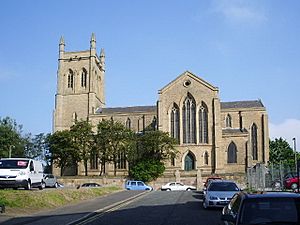Holy Trinity Church, Blackburn facts for kids
Quick facts for kids Holy Trinity Church, Blackburn |
|
|---|---|

Holy Trinity Church, Blackburn, from the south
|
|
| Lua error in Module:Location_map at line 420: attempt to index field 'wikibase' (a nil value). | |
| OS grid reference | SD 688,284 |
| Location | Mount Pleasant, Blackburn, Lancashire |
| Country | England |
| Denomination | Anglican |
| Website | Churches Conservation Trust |
| History | |
| Founder(s) | Rev J. W. Whittaker |
| Dedication | Holy Trinity |
| Consecrated | 12 July 1846 |
| Architecture | |
| Functional status | Redundant |
| Heritage designation | Grade II |
| Designated | 13 May 1987 |
| Architect(s) | Edmund Sharpe |
| Architectural type | Church |
| Style | Gothic Revival |
| Groundbreaking | 1837 |
| Completed | 1853 |
| Construction cost | £5,019 (equivalent to £350,000 in 2021) |
| Closed | 1981 |
| Specifications | |
| Materials | Stone |
Holy Trinity Church is a special old building in Blackburn, Lancashire, England. It used to be a church for the Anglican faith. Now, it is no longer used for regular services and is looked after by the Churches Conservation Trust. This church is also listed as a Grade II building, which means it is an important historical place.
Contents
History of Holy Trinity Church
Building Holy Trinity Church took many years, from 1837 to 1846. It cost about £5,019 back then. The church was one of the "Commissioners' churches." This means it received money from a special fund to help build new churches.
A famous architect named Edmund Sharpe designed the church. His cousin, Rev. J. W. Whittaker, who was the vicar (a type of priest) in Blackburn, helped start the project. The first stone was laid on October 11, 1837, by Bishop John Bird Sumner.
The church opened for people to worship in January 1846. It was officially made a sacred place on July 12, 1846. The church could seat 1,626 people. The tower was not finished until 1853 because there was not enough money. A tall spire that was planned for the top of the tower was never built.
In 1860, some changes were made inside the church. These changes were led by E. G. Paley, who took over Edmund Sharpe's work. The galleries (balconies inside the church) were rebuilt, and new seats were added. This created 200 more places for people to sit. The organ was also moved to a new spot behind the pulpit. These changes cost over £1,000.
From 1942 to 1949, Chad Varah was the vicar of Holy Trinity Church. He later started The Samaritans, a famous charity that helps people. In 1946, the side galleries were removed, but the gallery at the back of the church stayed. Holy Trinity Church stopped being used for regular services on April 1, 1981. It was then given to the Churches Conservation Trust on May 18, 1984.
Architecture and Design
Holy Trinity Church is built in the Gothic Revival style. This style looks like the old Gothic churches from the Middle Ages. The church has a main area called a nave with three sections. It also has north and south aisles, which are like side passages. There are also north and south transepts, which are parts that stick out from the sides, making the church look like a cross. At the very end is the chancel, where the altar is.
Exterior Features
The church's tower has three levels. It has tall, narrow windows called lancet windows on the lower levels. The top level has two twin-light openings on each side for the bells. At the very top of the tower is a flat wall called a parapet, with a pointed decoration called a pinnacle at each corner. All the windows in the church are very tall. The windows at the east ends of the transepts and the chancel are unusual. They have a pattern of 2-3-2 lights, which is more common in Germany.
Interior Features
Inside the church, there are slim columns called piers and a gallery at the back. The ceiling is flat and divided into 80 panels by decorative ribs. Each of these panels has a painting of a coat of arms. In the middle of the church, you can see the royal coat of arms of Queen Victoria. Other panels show the coats of arms of past monarchs, going all the way back to Edward the Confessor. There are also arms of bishops and other church leaders, including Rev. Whittaker. William Whewell, who supported Edmund Sharpe, also has his arms displayed. Artists like William Birch, Benjamin West, John Brocklehurst, and Samuel Driver painted these panels.
The church organ was originally from the Hanover Square Rooms in London. It was rebuilt and fixed by Gray and Davidson in 1851 and placed in the west gallery. Later, it was moved to the southeast side of the chancel and rebuilt again. In 1937, it was rebuilt and made larger by Laycock and Bannister.
Importance of the Church
Holy Trinity Church was officially recognized as a Grade II listed building on May 13, 1987. This means it is an important historical and architectural building. It is the largest and most impressive church designed by Edmund Sharpe. John Hughes, who wrote about Sharpe's life, called it his pièce de résistance, which means his greatest work.
See also
- Listed buildings in Blackburn
- List of architectural works by Edmund Sharpe
- List of Commissioners' churches in Northeast and Northwest England
- List of churches preserved by the Churches Conservation Trust in Northern England

